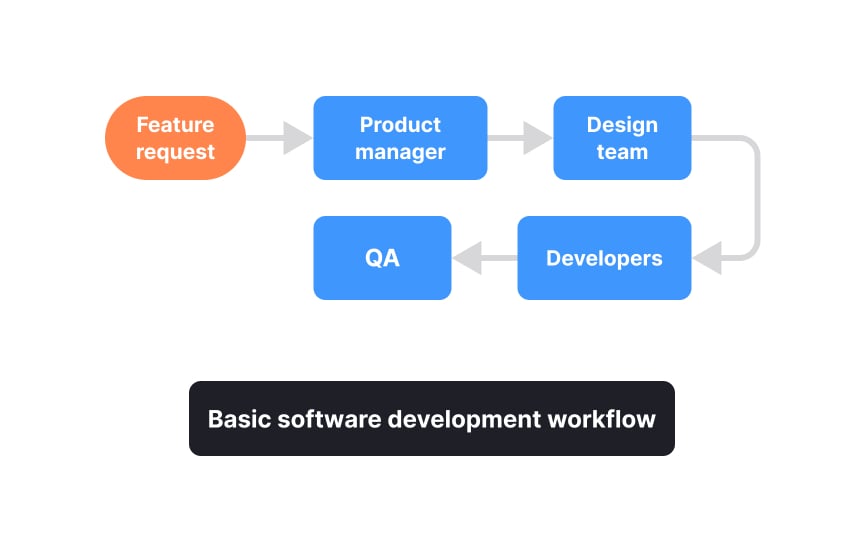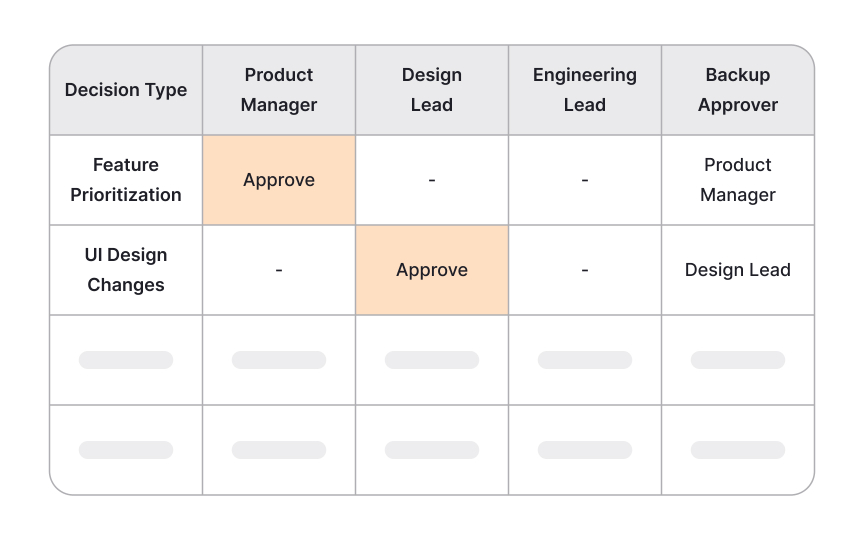Creating and Managing Cross-Functional Workflows
Learn the nuances of designing and implementing effective cross-functional workflows that drive team success
Cross-functional workflows connect designers, developers, product managers, and specialists through structured processes and clear touchpoints. These systematic approaches eliminate bottlenecks, reduce miscommunication, and create transparency across project stages. Well-designed workflows establish consistent checkpoints and feedback loops, maintaining team momentum while ensuring quality delivery. Modern management tools enhance this process through visual tracking, automated notifications, and centralized documentation.
The right workflow structure becomes a product development cornerstone, enabling quick adaptation and efficient iteration. Strategic planning considers each team's expertise and constraints, creating an environment where innovation thrives. As product development continues to evolve, these collaborative frameworks prove essential for coordinating diverse skills and perspectives toward shared goals.
Workflow maps visualize the sequence of tasks, decisions, and engagement within cross-functional teams. These visual representations highlight how work moves between different team members and departments, from initial concept to final delivery. For instance, feedback from users is collected by the product team. The map shows it moving to the design team for possible improvements, then to the development team for implementation, and finally, back to QA for testing.
A well-structured workflow map uses standard symbols to represent different types of activities and connections. Clear workflow maps document both the ideal process flow and alternative paths for handling exceptions or complications. They identify key decision points where teams need to evaluate progress or choose between different approaches. You can use digital tools like Lucidchart, Miro, or Figma to create and share workflow maps, ensuring clear communication and easy updates as processes evolve.
You can also use workflow maps to onboard new members, identify improvement opportunities, and ensure consistency in project execution. Including time estimates and resource requirements for each step helps plan effectively and allocate resources appropriately.
Pro Tip: Start mapping your workflow with sticky notes on a whiteboard before moving to digital tools — it's easier to experiment and get team input this way.
Comprehensive process
Effective documentation maintains a balance between providing sufficient detail and remaining adaptable to different scenarios. It should outline standard procedures while acknowledging where teams might need flexibility. For example, in a customer complaint call process, the documentation might specify the general steps for handling a complaint but allow customer service representatives to adjust their approach based on the severity of the issue. Including real-world examples and common edge cases helps teams understand how to apply guidelines in practice, such as how to handle a particularly irate customer or when to escalate a complaint to a supervisor.
Regular documentation reviews ensure that processes stay current with evolving team needs and technological capabilities. Establish a clear system for suggesting, reviewing, and implementing documentation updates.
Handoff protocols establish clear guidelines for transferring work between different functional teams, from research and design to development and quality assurance.
Here are some examples:
- When product management hands off to design, they should provide clear business requirements, user stories, and success metrics.
- Design teams need to deliver specifications, assets, and interaction
documentation to development. - Development handoffs to QA should include deployment instructions, testing environments, and known limitations.
- Marketing handoffs to design have to include brand guidelines, campaign objectives, and performance targets.
Each handoff should include a standardized checklist covering deliverables, acceptance criteria, and context.[1] Digital collaboration platforms like Linear, Confluence, or Notion can help streamline handoffs through automated
Pro Tip: Create role-specific handoff templates that outline exactly what each team needs to provide and receive for smooth collaboration.
Quality checkpoints establish clear evaluation criteria at crucial stages of product development.
Quality checkpoints should combine both automated checks and manual reviews where necessary. For example, tools like GitHub Actions automate code quality gates, ensuring that only clean and optimized code is integrated into the project. Deque's Axe is another powerful tool that automatically checks for WCAG compliance, helping ensure that digital products are accessible to all users, including those with disabilities. On the other hand, expert reviews focus on strategic alignment, user experience quality, and edge cases that automated tools might miss. Whether automated or manual, each checkpoint should have clear pass/fail criteria and
Regular analysis of checkpoint data helps identify common issues and improvement opportunities. You can use this information to refine your processes and provide targeted team training where needed.
Review cycles provide structured opportunities for feedback and improvement at different stages of a project. Each phase of the review focuses on specific aspects of the work, such as technical implementation, design quality, and
To make review cycles effective, assign clear roles and responsibilities for each stage. For instance, one team member may be responsible for reviewing code, while another reviews the user interface. Reviewers need explicit criteria for evaluation, such as ensuring code follows best practices or checking if the design meets
Time-boxing reviews, like setting a 30-minute limit for each review session, ensures the team maintains project momentum while still addressing key issues. Automated reminders in project management tools (e.g., Asana or Trello) can be set up to notify reviewers of upcoming deadlines.
Pro Tip: Conduct review cycles at the end of each sprint or at key milestones, such as design sign-offs or feature completions.
Approval processes define the chain of authority and decision-making steps within cross-functional workflows, ensuring that all decisions are made by the appropriate stakeholders. Clear approval hierarchies prevent confusion and help identify who needs to be involved at each stage. Each approval stage should have designated backup approvers to prevent delays in case the primary approver is unavailable.
Approval processes should balance thorough oversight with maintaining project momentum. Teams should identify which decisions require multiple approvals and which can be delegated. For instance, minor design tweaks may only need approval from the design lead, while major feature changes may require approval from both the design and product teams.
To begin with, create an approval matrix that clearly shows which roles can approve different types of decisions to speed up the process. Most digital
Change management protocols help teams adapt workflows while maintaining stability and efficiency. These protocols define how to propose, evaluate, and implement process changes without disrupting ongoing work. For example, when a company switches to a new
Successful change management requires both technical implementation plans and strategies for supporting team adaptation. For instance, the change management plan might outline the new tool's integration process and provide training sessions for team members to get up to speed. Phased and gradual implementation allows teams to test changes in smaller, manageable sections before full adoption.[2]
Create a change impact assessment template to evaluate both technical and human factors before implementing workflow changes. This template could include questions like: "What technical resources are needed?", "How will this change affect team roles?", and "What potential challenges might arise during implementation?"
Bottleneck identification helps teams find and fix problems in their workflow that slow things down. For example, if a team notices that tasks get stuck in the "Review" stage for too long, they can identify that as a bottleneck. Regularly checking how work is moving through the pre-determined process helps teams spot common delays or areas where resources are limited. Teams can look at both numbers (like how much time tasks spend in each stage) and team feedback to find these problem areas.
Regular team check-ins, like retrospectives, give teams a chance to talk about any new bottlenecks before they affect deadlines. Solutions could include changing the way work is done, shifting resources around, or adding automation tools to make things faster. For example, if the testing phase is always delayed, the team might decide to automate some of the testing to speed it up.
Automation streamlines repetitive tasks in cross-functional workflows. For example, when designers update a component in the design system, automated
Other common automation scenarios include categorizing and assigning project status reports, handling bug reports from users, generating release notes from commit messages, creating recurring sprint tasks, syncing documentation across platforms, and managing routine code reviews. These repetitive but essential tasks often consume valuable team time that could be better spent on complex problem-solving.[3]
How do you decide which tasks need automation? Document your manual processes step by step for two weeks — tasks you repeat more than twice per week are prime automation candidates. Look for automation capabilities in your existing tools first — many platforms like Monday.com, Figma, and GitHub offer built-in automation features that typically integrate better with your workflow than third-party solutions.
Scale considerations ensure workflows remain effective as teams and projects grow — what works for 5 people often breaks at 15. Here are some actionable steps to manage scaling in cross-functional teams:
- Centralize systems: Organize and standardize your team's current successful processes, tools, and
assets into a centralized location where they can be easily accessed and managed. - Automate notifications: Implement automated
notifications for updates, component usage, and newdocumentation to ensure all team members stay informed. - Break into focused pods: Split larger teams into smaller, focused pods (e.g., 5-7 members per pod), with a dedicated designer, developer, and product owner in each. This keeps collaboration agile while still allowing for scalability.
- Create self-service documentation: Develop FAQs and detailed documentation to answer common questions, enabling teams to access information quickly and reduce dependence on team leaders.
References
- Project Handover Templates & Checklists for Effective Transitions | project-management.com
- Essential automation strategies for product managers | Product-Led Alliance | Product-Led Growth
Top contributors
Topics
From Course
Share
Similar lessons

Who is a Design Leader?

Leadership Styles





















